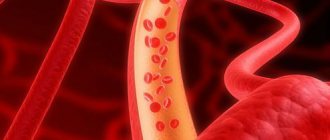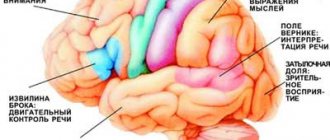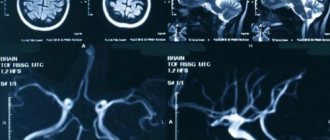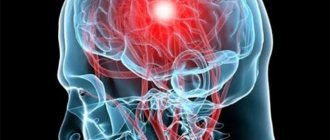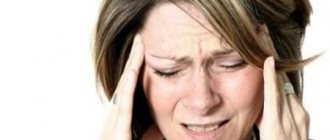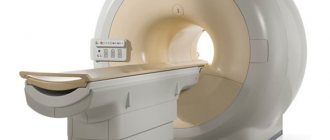Drugs that improve blood circulation in the brain are indicated for disorders of various origins. There can be many causes of problems with cerebral vessels, and the main ones are the following:
- atherosclerosis;
- stroke;
- head injuries (craniocerebral);
- osteochondrosis;
- systemic diseases;
- hypertension.
All of the above pathologies are accompanied by dizziness, memory loss, headaches and require mandatory treatment. Therapy is especially relevant after an ischemic stroke.
Who may need vascular medications?
In early childhood, changes in blood flow in the brain are a consequence of perinatal encephalopathy, birth trauma, hypoxia during childbirth, and pressure drop during cesarean section. If a treatment plan is drawn up correctly, the child’s condition will normalize within 2-3 years. If the baby has cerebral palsy and other serious diseases, he will have to take vascular medications for the rest of his life.
School-age children grow quickly, and vascular medications may be needed due to the increased workload.
In adults, cerebral circulatory disorders are even more common - due to heart disease, osteochondrosis, ischemia, thrombosis, injuries, and operations.
In older people, the blood vessels of the brain suffer from atherosclerosis - blockage of the arteries with plaques. All of these categories of patients have indications for taking vascular drugs.
Recovery after a heart attack or stroke
After damage to the heart muscle, a long period of rehabilitation is required. A prerequisite is exercise therapy - physical therapy, which is prescribed by a specialist. These will be smooth bends and turns of the body, walking in place and long walks. If you do not pay attention to physical activity, the heart muscle will not receive enough oxygen and nutrients for full recovery.
IMPORTANT! After myocardial damage, the intensity of exercise should be monitored. During gymnastics, the pulse should remain within 120 beats per minute.
Exercises for the heart and blood vessels are a mandatory way to prevent many diseases. Without physical activity, blood volume decreases, arteries and veins lose elasticity, and movement through the capillaries slows down. It is important to take care of the condition of the cardiovascular system as early as possible so that they remain healthy in old age.
Calcium channel blockers
These medications are among the most popular among neurologists and therapists. Due to a decrease in the amount of calcium in cell membranes, the vascular walls relax, their lumen expands, and blood flow increases. The amount of nutrients and oxygen reaching the brain also increases. The tone of the veins does not change, which is important for maintaining normal venous outflow. There are a number of proven drugs, as well as new generation drugs.
Which ones are better to choose? The list of the most popular is given in the table.
| Generation | Name of medicine | Group |
| First | Verapamil | Phenylalkylamine derivatives |
| First | Nifedipine | Dihydropyridine derivatives |
| First | Diazem | Benzothiazepine derivatives |
| Second | Isradipin | Benzofurazanil derivatives |
| Second | Plendil | Dihydropyridine derivatives |
Currently, third-generation drugs are being developed that have even fewer side effects and contraindications. The above remedies can also treat arterial hypertension. Vasodilators are contraindicated during pregnancy and lactation.
Leg workout
The most common vascular disease of the lower extremities is varicose veins. It develops as a result of a decrease in the tone of the vascular walls, which is why pathological cavities appear on them. Venous blood stagnates in them, which is accompanied by inflammation and swelling of the legs. Varicose veins occur especially often in middle-aged and older women, as well as in overweight patients. This factor leads to a constant increased load on the distal parts of the limbs and to difficulties in their blood supply.
In everyday life, the vessels of the lower extremities bear a lot of load, so it is important to train them
Daily strengthening of the muscles and blood vessels of the legs will help to avoid problems, including in old age. A simple set of exercises was created specifically for those who want to take care of their health and strengthen the vascular walls in advance:
- in a standing position (legs should be slightly wider than shoulders), slowly lower down and touch the ground with your hands;
- sitting on the floor, spread your legs as wide as possible, try to touch the ground with your arms or shoulders folded on your chest;
- walking on your knees.
If there are no contraindications, it is useful to go for a run every day. This sport strengthens all the muscles of the body, helps control weight, increases the respiratory volume of the lungs and activates blood circulation. However, running is contraindicated under the following conditions:
- chronic diseases of the joints of the lower extremities (arthritis, arthrosis);
- injuries;
- low or high blood pressure.
A good alternative to running is swimming. In water, the load on the joints is less, and the muscles work just as intensely. In addition, during water sports, blood circulation in the distal extremities increases. In everyday life, blood reaches the hands and feet last.
Antioxidants and antihypoxants
Such medications are always prescribed as part of complex therapy to improve cerebral vascular function. They quickly eliminate the symptoms of oxygen starvation and help strengthen vascular walls. Here is a list of the best medicines:
- Actovegin
(630 rubles). Activates tissue metabolism, eliminates hypoxia, optimizes trophism and recovery processes. The drug is obtained from the blood of animals, therefore, in addition to allergies, it has a small number of side effects. - Mexidol
(470 rubles). It is one of the best antihypoxants, membrane protectors, and nootropics. The medicine is administered intramuscularly or taken in tablet form. It increases the body's resistance to various damaging factors. With long-term use, the medicine somewhat thins the blood and reduces the accumulation of lipids, lowering cholesterol. - Emoxipin
(250 rubles). Antioxidant, stabilizer of cell membranes, reduces vascular permeability. Has a retinoprotective effect. Most often prescribed if cerebral disorders affect the condition of the retina. - Glycine
(40 rubles). This amino acid is a natural brain metabolite, a neurotransmitter, that helps regulate metabolism in brain tissue.
Complamin, Glutamic acid, Picamilon and other antihypoxic and antioxidant agents also improve the functioning of cerebral vessels.
Vasodilators
This is a large group of medications that are used to treat various diseases. Vasodilators dilate blood vessels and thereby improve the supply of blood, and therefore useful substances, to brain cells and the central nervous system. They stimulate cellular metabolism and energy metabolism, thereby increasing brain activity. They are also used as heart medications.
Calcium antagonists
They have a relaxing effect on the arteries, while the tone of the venous walls does not change. Calcium channel blockers have long been successfully used to treat cardiovascular pathologies. Today the third generation of these drugs is being produced.
Nifedipine is a drug for cerebral vasodilation from the group of calcium antagonists
First generation drugs include:
- Nifedipine,
- Delacor,
- Verapamil.
Second generation drugs:
- Felodipin,
- Klentiazem,
- Verapamil SR.
New generation drugs are represented by a group of dihydropyridines, including:
- Norvasc,
- Stamlo,
- Alodipine.
These medications should be taken with caution, as they can have a systemic effect on the body.
Alpha blockers
These drugs improve metabolism in tissues and blood flow in the vessels of the brain, and help with oxygen starvation, which developed as a result of vasospasm. These include Sermion and Nitsergoline derivatives.
Antispasmodics
They relax the smooth muscles of the vascular walls and expand the lumen of blood vessels. Antispasmodics are considered the mildest and safest of vasodilators, but they should be taken with caution by older people. The fact is that they practically do not work on vessels affected by atherosclerosis and redistribute blood in favor of healthy areas. Therefore, they are generally not suitable for older people. People in this age category are prescribed calcium channel blockers. The most commonly used antispasmodics are drotaverine hydrochloride and no-spa.
Antispasmodics are excellent for headaches caused by cerebral vasospasm
Combination drugs
They contain substances that have different actions. This group includes:
- Instenon - includes etomivan, etophylline, hexobendine.
- Vasobral - it contains caffeine and alphadihydroergocriptine.
Vitamins and minerals
The next group of vasodilator drugs for the brain are vitamin supplements that are urgently needed for the normal functioning of blood vessels. Most often, patients are recommended drugs based on nicotinic acid in injections.
The medicine improves the metabolism of nitrogenous substances and carbohydrates, dilates blood vessels, and reduces cholesterol. Nicotinic acid also improves blood microcirculation in the brain and replenishes vitamin B3 deficiency.
The main preparations with vitamins are Nicotinamide, Niacinamide, Nicotinic acid in ampoules.
Rutin is another remedy that strengthens blood vessels. Troxerutin and Ascorutin are made on its basis; they are prescribed against the fragility of small capillaries, to reduce the permeability of vascular walls, as an antioxidant.
Also, patients with vascular diseases are recommended to regularly take tablets with retinol, tocopherol, potassium, selenium, and silicon. For osteochondrosis of the neck and other diseases of the spine, a complex of B vitamins - Neuromultivit, Compligam, Milgamma - is always introduced into the course of therapy.
Exercises for the heart
The heart is an organ that works constantly. His condition may worsen with age, as well as with increased workload. Weakness of the heart muscle is often observed in overweight patients with concomitant pathologies. The only way to keep it in good shape even in old age is to train regularly.
Exercises can be started as morning exercises, immediately after waking up. The simplest of them, which is suitable as a warm-up, is rotation of the hands and feet. Such movements accelerate blood flow in the distal parts of the extremities, dilate blood vessels and stimulate the heart. Next, you can proceed to the main set of exercises for blood vessels and the heart.
- To begin with, you can rise high on your toes and walk with your knees high. This exercise activates blood circulation in the lower extremities.
- Starting position: standing, feet wider than shoulder width. The hands are on the belt, and the body must perform smooth deep bends.
- In a standing position, spread your arms as wide as possible to the sides. Next, the palm of the right hand touches the left shoulder and, conversely, gradually increasing the speed. You can do up to 50 repetitions in one approach.
- Another useful exercise is circular rotation of the arms in the shoulder joints. With both hands, make a full circle at the same time, first in the forward direction, then backward.
- While lying on your back (especially before going to bed), do the “bicycle” and “scissors” exercises.
IMPORTANT! Heart exercises don't have to be fast and intense. In the absence of pathologies, you can gradually increase the load by adding running and other cardio exercises.
Nootropics
These medications do not act directly on blood vessels, but they improve overall metabolism in tissues, stabilize neurocyte membranes, increase tissue resistance to oxygen starvation, thereby optimizing blood supply to the brain. Nootropics are prescribed even to children, they are indicated for most elderly people, and are used in the complex treatment of osteochondrosis, atherosclerosis, hypertension, the consequences of cerebral palsy, etc.
The cheapest and most accessible are racetams - Piracetam, Nootropil, Lucetam, Phenotropil and others.
The latest generation of drugs includes Cortexin, which is a complex of polypeptides from the animal cerebral cortex. The medicine is injected into the muscle; it is available only in injection form. Price for 10 ampoules - 1300 rubles.
Patients are also given the following injections:
- Cerebrolysin;
- Vinpocetine;
- Cavinton;
- Telektol;
- Bravinton.
Many nootropics have a positive effect on blood composition - they prevent platelets from sticking together, improving blood microcirculation by increasing its fluidity. This helps to avoid thrombosis and other serious complications of vascular pathologies.
Drugs that reduce blood viscosity
Anticoagulants and antiplatelet agents improve blood fluidity and reduce its viscosity, which leads to normal blood supply to the brain.
Anticoagulants
This category of medicines includes the following drugs:
- Heparin,
- Warfarin,
- Fragmin,
- Clexane,
- Fraxiparine.
They improve microcirculation in blood vessels and reduce blood clotting. These drugs are taken under the supervision of a doctor. To prevent bleeding, blood is periodically donated for biochemistry.
Anticoagulants are used only under the supervision of a doctor and as prescribed.
You should immediately consult a doctor if, after taking anticoagulants, bruises on the body, black feces, or vomiting blood appear.
Antiplatelet agents
Antiplatelet agents reduce blood viscosity. They are indicated for those with a tendency to thrombosis and micro-strokes. They help prevent thromboembolism. In case of cerebrovascular accidents, they are prescribed only after examining the patient and studying the results of all his tests. This group includes:
- Aspirin,
- Chime,
- ThromboASS,
- Ticlopidine,
- Aspilat.
Medicines for atherosclerosis
If a person is diagnosed with atherosclerosis, treatment with folk remedies or so-called vascular cleansing is not always enough. Atherosclerosis of cerebral vessels is a very serious disease; without treatment it leads to stroke.
The following will help improve blood circulation in this pathology:
- Statins
- Rosuvastatin, Atorvastatin, Lovastatin. Many people have to take these medications for several years; they normalize cholesterol levels and prevent it from depositing in the blood vessels. Unfortunately, statins have a bad effect on the liver and other internal organs and can cause a number of side effects. - Fibrates
- Fenofibrate, Clofibrate. They increase “good” cholesterol while reducing “bad” cholesterol. The course usually lasts up to 2 months, then take a break. - Other means - bile acid sequestrants
. These medications are Cholestyramine and Cholestipol. They bind the cholesterol present in the intestines and remove it, preventing it from being absorbed.
In mild cases of atherosclerosis, it is enough to take Omega-3 acids, which strengthen the walls of blood vessels and prevent the disease from progressing.
Improving blood circulation in the brain - physical activity and exercise
Physical inactivity (lack of physical activity) can be caused by many factors - from sedentary work to basic laziness. It has a number of negative consequences, including problems with the cardiovascular and respiratory systems, bones33,34.
In the context of cerebral circulation, lack of physical activity is associated with an increased risk of blood clots35 and deterioration of the conductive capacity of gray matter (a major component of the central nervous system)36. Therefore, anyone who leads a sedentary lifestyle is recommended to take regular walks, run every night, practice Nordic walking, or workout in the gym.
Research shows that regular physical exercise has a beneficial effect on blood flow throughout the body, including the brain37,38. There are special sets of exercises to improve blood circulation in the brain, and there are also specialized programs implemented in the presence of certain pathologies.
A set of exercises to improve blood circulation in the brain:
– Take a sitting position, looking straight ahead, turn your head 45 degrees to one side, then to the other.
– Slowly rotate your head in a circle, first to the right, then to the left.
– Tilt your head up so that your chin points to the ceiling. Then lower your head to your chest and touch your chin to your chest.
– Bend to the right and left towards your shoulders so that your ear touches your shoulder. The shoulders are motionless.
– Looking straight ahead, stretch your head forward as much as possible, return it to its original position and pull it back as far as possible.
The entire complex is performed as slowly and carefully as possible. The purpose of exercises to improve blood circulation in the brain is to relax the muscles that compress the blood vessels and normalize blood flow. Each movement is performed 10-15 times; for sedentary work, it is recommended to perform the complex 2-3 times during the day at approximately equal intervals.
Exercises to improve blood circulation in the brain with cervical osteochondrosis include neck rotations, lateral flexions, rotation, retractions, and stretching of the trapezius muscle. The figure below shows an example of such a complex.
There are many specialized complexes of medical gymnastics to improve blood circulation in the brain in case of osteochondrosis of various joints39,40. It is unacceptable to perform these exercises on your own; they are performed only under the supervision of a specialist, or as directed and after consulting a doctor.
Other drugs
Often a person experiences vascular spasms (when taking vasoconstrictor medications, hypertension, smoking, etc.). In this case, antispasmodics will help improve blood flow - No-shpa, Revalgin, Drotaverine, Papaverine. Doctors also prescribe as vascular agents:
- antiplatelet agents (thin the blood) - Warfarin, Heparin, Aspirin;
- medicines with ginkgo biloba (increase blood supply to the brain) - Tanakan, Gingikum, Bilobil.
You cannot select treatment regimens on your own - it is important to make prescriptions taking into account the exact indications and type of disease, to know the contraindications, side effects and effectiveness of the active substances.
Herbal preparations
The active substances of these medicines are alkaloids of plant origin. It is believed that these drugs have virtually no contraindications. They are used both for the prevention and treatment of cerebral circulatory disorders. Tablets based on plants such as ginkgo biloba and periwinkle are especially common.
Preparations with ginkgo biloba extract have a complex effect on the blood vessels of the brain:
- enhance microcirculation;
- relieve vasospasm;
- strengthen their walls and improve permeability;
- relieve swelling of brain tissue.
The following vascular drugs in this group are especially popular:
- Ginkor Fort,
- Tanakan,
- Bilobil,
- Gingium,
- Ginkum,
- Ginkgo Biloba C,
- Memory,
- Doppelgerz Ginkgo Biloba +.
It is important to know that while taking ginkgo biloba preparations, you should not take blood thinners to avoid bleeding in the brain.
Taking these medications is long-term, and the first improvements may appear after about a month of treatment. The general course of therapy is about three months.
The most famous preparations based on periwinkle:
- Cavinton,
- Telektol,
- Vinpocetine,
- Bravinton,
- Vero-Vinpocetine.
These products have the following characteristics:
- have an antispasmodic effect;
- prevent thrombosis;
- improve blood circulation in the brain;
- normalize the metabolism in its cells.
It is not recommended to take these medications on your own. The dosage and duration of administration are determined by the attending physician.
Ginkgo biloba is a raw material for a large number of medications to improve brain function
The best drugs for the blood vessels of the head
It is possible to resume the stable operation of the processes occurring in the organs of the central nervous system if you follow the exact instructions for natural medicinal products and modern vasodilating drugs.
- Actovegin
. Promotes oxygen saturation of tissues and organs, has an antioxidant effect, restores blood flow, and prevents the onset of ischemic stroke. Daily dosage: 1-3 capsules before meals 3 times. Intravenous administration involves 10-15 ml of the drug in combination with a 0.9% NaCl solution or 5% dextrose. - Vasobral
. Vasodilating drug. Reduces the permeability of the vascular wall, restores cerebral circulation, increases mental activity, reflex excitability of the spinal cord and increases the activity and stability of the brain. Eliminates attention, memory and vestibular complications. Prescribed 0.5 - 1 tablet in the morning and evening. In the form of a solution, it is recommended to take 2-4 ml twice a day. - Ceraxon
. The nootropic active ingredient promotes the restoration of cells and damaged tissues. Reduces the effects of memory loss, improves attention and thinking. For traumatic brain injuries and heart failure, it reduces the duration of associated symptoms. In the acute ischemic period, intravenous administration of 1000 ml is recommended.
Improving blood circulation in the brain - diet and drinking regimen
A diet to improve blood circulation in the brain is selected based on the metabolic characteristics and condition of a particular person. Before adjusting the diet, it is recommended to conduct the following studies: daily blood pressure monitoring, blood tests for glucose and cholesterol, and a coagulogram. Based on research results, it is necessary to adjust the amount of salt, sugar, animal fat and other products in the diet24,25,26.
Diet recommendations to improve blood circulation in the brain:
– The consumption of salted, smoked and canned foods is usually limited in the presence of arterial hypertension, based on the recommendation - no more than 4.5 grams of salt per day.
– Restrictions on the amount of animal fat (fatty meat, lard, milk, butter) are determined by the presence of hypercholesterolemia, which sets the upper limit - 1 gram of fat per 1 kg of weight.
– The amount of monosaccharides and disaccharides (glucose, sucrose and foods high in them) is limited when blood glucose is high. In this case, preference is given to polysaccharides, which are found, for example, in durum cereals and pasta.
– Since vitamin K actively stimulates blood clotting, if this indicator increases, it is recommended to limit all foods high in vitamin K (white cabbage, broccoli, spinach, lettuce, soy, eggs, dairy products, green tea).
Research shows27 that foods high in sodium reduce central perfusion pressure, which measures the level of blood flow to the brain. In this regard, outside of pathologies, it is recommended to avoid excessive consumption of foods high in sodium - salt, herring, caviar, almost all cheeses, beef kidneys, feta cheese, dry cream, powdered eggs.
Injections for cerebral vessels
The following vascular drugs are often used for injection:
- Vinpocetine, Cavinton and Bravinton are alkaloid derivatives
. They help normalize the nutrition of nerve cells and also significantly improve blood flow. These are new generation drugs to improve cerebral circulation. - Nicotinic acid, Nikoshpan are derivatives of nicotinic acid
. This type of product can be purchased at a pharmacy only with a prescription written by a doctor. - Drotaverine (No-shpa)
. As a rule, this drug is prescribed in the form of tablets. However, it is sometimes also used in injectable form. This drug is considered harmless, inexpensive, and has the fewest contraindications. - Nootropic drug, Piracetam
. Such drugs can improve brain nutrition and relieve spasms. They are often taken by older people as a preventative against dementia. - Eufillin
. This medicine has a vasodilating effect and also has a beneficial effect on oxygen supply to the brain. It is contraindicated for diseases of the gastrointestinal tract, glaucoma, and for problems related to blood pressure.
Breathing exercises
Breathing exercises are the basis for many yoga asanas and other, more modern complexes. There is a wide variety of breathing patterns, but they are all based on basic principles:
- slowly filling the lungs with oxygen through the nose and exiting through the mouth;
- diaphragmatic breathing;
- alternating thoracic and abdominal types of breathing.
Proper breathing is important not only during training, but also in everyday life. If you learn to control yourself and breathe slowly and deeply, the degree of saturation of cells with oxygen increases noticeably.
Slow and deep breathing is a prerequisite for proper performance of all exercises.
Drugs for cervical osteochondrosis
Osteochondrosis is a disease accompanied by pain in the spine that interferes with everyday activities. The use of non-steroidal anti-inflammatory drugs for osteochondrosis helps alleviate the health condition: they eliminate the inflammatory process in the tissues of the spine, thereby relieving pain. But not all anti-inflammatory drugs are equally effective and safe for the body.
- Diclofenac
. Included in the anti-inflammatory drugs Voltaren, Ortofen, Diclak, Flotak, Diclobene. The analgesic and anti-inflammatory effects are equally well expressed. It inhibits both forms of the COX enzyme, but to a greater extent COX-2, so drugs with Diclofenac are less likely to cause gastrointestinal lesions than other first-generation NSAIDs. - Ibuprofen
. Preparations with ibuprofen (Dolgit, Nurofen, Ibalgin, Solpaflex) have a pronounced analgesic effect, the anti-inflammatory effect is somewhat weaker. Clinical studies have shown that the incidence of adverse reactions after taking therapeutic doses is the lowest among all non-selective NSAIDs. - Indomethacin
. One of the oldest representatives of the group of non-steroidal drugs. It has proven itself as a powerful analgesic and anti-inflammatory agent for osteochondrosis and other rheumatic diseases. But taking this drug is unsafe in terms of the development of serious complications of the gastrointestinal tract, central nervous system, heart failure and has many contraindications. It is used only occasionally for unbearable pain.
Improving blood circulation in the brain - bioactive supplements
Most dietary supplements for improving brain circulation are nootropics, the mechanism of action of which is related to stimulating blood flow. One of the popular nootropics with this mechanism of action is glycine. This is an aliphatic amino acid that functions as a neurotransmitter and has an “inhibitory” effect on neurons, which gives a mild sedative effect.
Glycine reduces the release of GABA and glutamic acid and stimulates blood circulation in the brain. Target effects – relieves irritability and aggressiveness, eliminates chronic fatigue syndrome, improves brain function, stimulating cognitive functions (memory, reaction, attention).
Among nootropics there are not only amino acids, but also extracts, for example, ginkgo biloba extract. It contains 24% flavonoids, vitamins, minerals and other bioactive substances. It has a vasodilating effect, improves blood flow to the brain and blood flow inside the organ. It also stabilizes blood pressure and cholesterol levels, improves microcirculation. Helps eliminate neurocirculatory dystonia and chronic fatigue syndrome caused by psycho-emotional stress.
Complex supplements, such as “Healthy Sleep,” will help improve blood circulation in the brain, eliminate anxiety and normalize sleep. This supplement includes glycine, gamma-aminobutyric acid, tryptophan, melatonin and 4 extracts - lemon balm, passionflower, valerian and chamomile. The benefit of the supplement is that it not only stimulates blood circulation in the brain and improves cognitive function, but also stabilizes the sleep/wake cycle, helping to get enough sleep.
Traditional methods of treatment
Today, home medical treatment methods are not inferior to modern methods of treatment, so many people prefer to be treated and prevent dystonia on their own, using the gifts of nature. Herbalists suggest treating narrowed blood vessels in the brain with effective herbal infusions.
- You need to take a couple of particles, divided equally: burdock root, eleutherococcus fruits, mint and birch leaves, marsh cudweed, kidney tea. Pour half a liter of hot water over the entire mixture and leave for 30 minutes. For the best effect, you need to drink one hundred ml of liquid three times per 24 hours.
- Mix St. John's wort, chamomile, immortelle, birch buds and add a few glasses of hot water. We divide the collection in half and drink it twice every day with a small spoon of honey and bay leaf oil.
- We take clover, 5 parts of wormwood, a couple of pieces of myrtle, one piece of marjoram and half a share of parsley seeds. A liter of hot water is added to three large spoons of the product. Let the broth sit for a couple of hours, drink 1 fourth cup every few hours.
- Boil the mixture with pine needles, onion peels and rose hips, and let it sit. We drink half a liter a day for 3 months, dividing the portion into morning, lunch and evening.
- Take one large spoon with chopped burdock rhizome, fill it with half a liter of water and leave it in a thermos for infusion. We drink 100 ml in the morning for 3 months.
Before using traditional recipes, you should consult your doctor.
Products to improve blood circulation in the brain:
– amino acids of animal and plant origin (meat, legumes);
– seafood (mussels, shrimp) and sea fish (mackerel);
– vegetables and fruits high in vitamin C and group B;
– cereals, nuts, berries and citrus fruits (rich in bioflavonoids).
Drinking regime
– a separate item in the program for improving blood circulation in the brain. Research shows that sufficient water consumption (2.5 liters per day in the absence of additional instructions due to pathologies) is the prevention of blood clots. However, in case of pathologies, it is still necessary to use antiplatelet agents or anticoagulants prescribed by a doctor.
Thirst quenching is also necessary for the development of neural populations28,29. The latest research shows that molecular hydrogen in drinking water protects the brain from neurodegenerative changes of various origins, including those caused by traumatic brain injury30. Therefore, to improve blood supply to the brain, it is necessary to drink enough water, and the drinking regime should be regular - the recommended 2.5 liters must be evenly distributed throughout the entire waking period.
Please note that 2.5 liters is an average. According to research, women on average need to drink less water than men (2.2 liters and 3 liters per day, respectively)31. Also, the recommended daily amount of water is determined by weight, age and lifestyle32. Below is a table of recommended daily water intake.
